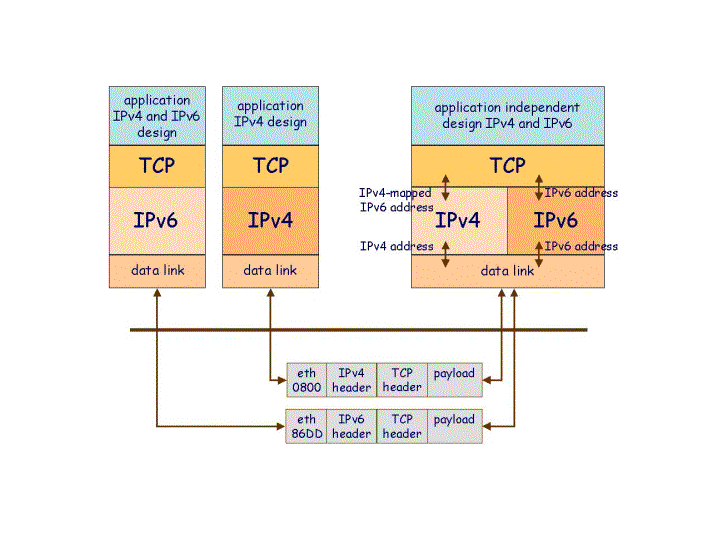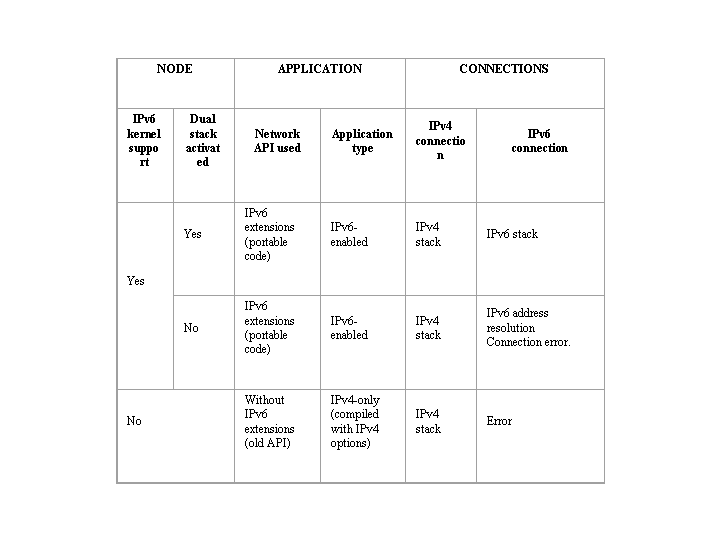
Figure
- Protocol independent application on dual-stack host
Although
applications are written following program protocol independent
rules, other points have to be considered such as the movement of
binary code between IPv4-only nodes, dual stacks nodes or IPv6-only
nodes.
Compilation options (#ifdefs in C language) can be provided throughout the code to select the proper use environment. If IPv6 is not supported the IPv4-only code will be selected for compilation during installation process. However, if IPv6 is supported (Kernel level support) by installed systems, the code for IPv6 or the IPv4 could be selected for compilation, depending on the requirements of applications. Notice that if IPv6 is supported by the kernel, it only means the IPv6 option could be activated and while this option is disabled the node will be only use IPv4 stack. During the transition period nodes are usually running dual stack, both IPv4 and IPv6 stacks. The problem with the conditional compilation approach is that the code becomes littered with compilation options very quickly and harder to follow and maintain.
If an application is compiled on a system which supports dual stack and move the binary code to an IPv4-only node without IPv6 kernel support, the source code must be recompiled to use the original IPv4 API. The binary code generated on the dual stack uses the new system functions which are not supported in the IPv4-only node.
If the binary code is moved, which has been compiled on a dual stack, to an IPv4-only node with IPv6 kernel support and IPv6 stack not activated, recompilation is not required. Since the IPv6 stack is not activated, the node can not establish IPv6 connections. However, the resolver system could return an IPv6 address to an application query and the application should be prepared to discard this IPv6 address and select the IPv4 one to open connections.
All these alternatives are summarized in Table 4.
Compilation options (#ifdefs in C language) can be provided throughout the code to select the proper use environment. If IPv6 is not supported the IPv4-only code will be selected for compilation during installation process. However, if IPv6 is supported (Kernel level support) by installed systems, the code for IPv6 or the IPv4 could be selected for compilation, depending on the requirements of applications. Notice that if IPv6 is supported by the kernel, it only means the IPv6 option could be activated and while this option is disabled the node will be only use IPv4 stack. During the transition period nodes are usually running dual stack, both IPv4 and IPv6 stacks. The problem with the conditional compilation approach is that the code becomes littered with compilation options very quickly and harder to follow and maintain.
If an application is compiled on a system which supports dual stack and move the binary code to an IPv4-only node without IPv6 kernel support, the source code must be recompiled to use the original IPv4 API. The binary code generated on the dual stack uses the new system functions which are not supported in the IPv4-only node.
If the binary code is moved, which has been compiled on a dual stack, to an IPv4-only node with IPv6 kernel support and IPv6 stack not activated, recompilation is not required. Since the IPv6 stack is not activated, the node can not establish IPv6 connections. However, the resolver system could return an IPv6 address to an application query and the application should be prepared to discard this IPv6 address and select the IPv4 one to open connections.
All these alternatives are summarized in Table 4.
Table
- IPv4 or IPv6 activation


In
summary, if applications follow the recommendations explained
above, using a separated protocol independent transport module,
which provides a generic communication API, it is easy to adapt them
to new network protocols. Besides, the generic communication API
could be implemented as a communication library to be used for many
applications. This solution encourages the code reusability and makes
communication modules of applications easy to maintain.